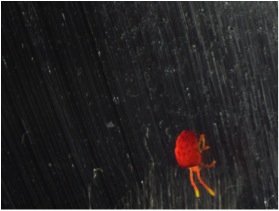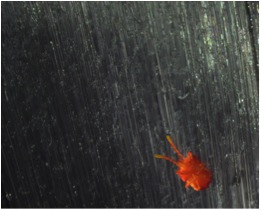Red Velvet Mite
Contact
Katharine Ordway Natural History Study Area9550 Inver Grove Trail Inver Grove Heights, MN 55076 651-455-6204 (On Site)
651-696-6230 (On Campus)
andersonm@macalester.edu
Biotic Inventory: Documenting Diversity at the Katharine Ordway Natural History Study Area
Trombidium species


Linnaean Taxonomy
Though the exact species name of my biotic inventory is not known, I was able to narrow the scientific name for the organism commonly referred to as the Red Velvet Mite to the Genus level. It is thought by scientists that there are thousands of species of mites within this genus. The Linnaean Taxonomy for the Red Velvet Mite is as follows:
Domain – Eukarya
Kingdom –Animalia
Phylum – Arthropoda
Subphylum – Chelicerata
Class – Arachnida
Subclass – Acari
Superorder – Acariformes
Order – Actinededa
Suborder – Parasitengona
Superfamily – Trombidiodea
Family – Trombidiidae
Genus – Trombidium
Species – ?
As far as I know, the Red Velvet Mite that would typically be found at Ordway are known only by this common name, but one of its more notorious relatives, Trombidium grandissimum, is known by several names, including Bir Bahuti, Scarlet Fly, Lady Fly, Velvet Buchi and Rani Keeda which means Queen Mite. Since these mites are often found during monsoon season, they are also known as Rain mites. This organism is endemic to the Indian subcontinent.
Diagnostic Tests
After gathering my specimen, I went to the field station to identify what I had found. It was obvious to me that, since this organism had four pairs of legs, that it must be some type of arachnid. I then looked into a field guidebook on spiders and their allies. This book included information not only about spiders, but also about mites and ticks. After several minutes of thumbing through the book, I realized that it was a mite, and by looking at the picture in the guidebook, it was obvious that the organism that I had found was a red velvet mite. Although Mites and ticks are some of the most diverse Arthropod lineages, they are characterized by four pairs of legs. Juveniles only have three pairs, but as they progress in their life history and molt, they gain a fourth pair. Unlike many Arthropod lineages, there is no delineation between the body segments. There is no separate abdomen, head, and thorax, simply a fused body of all three parts called the abdomen. It is important to note that neither mites nor ticks have antennae. The red velvet mite falls under the group called the chelicerates, which means that they use modified appendages called chelicerae to eat their prey. Since mites have chelicerae, they are closely related to organisms such as scorpions, harvestmen, and spiders.
The red velvet mite is normally found in the underbrush of wooded areas, which is exactly where I found my specimen. The mite stood out because of its characteristic red pigmentation. The red velvet mite grows to be about 1 centimeter long, which is consistent with my specimen. Very small hairs found on the organisms give it a soft, velvety exterior, hence its name the red velvet mite. Some of these hairs are used as feelers. Finally, based on the images of the field guide and the lack of alternative species that it could be, I concluded that my specimen was in fact the Red Velvet Mite.
Ecology
Red Velvet Mites are an integral part of the soil and leaf litter ecosystem. Since these mites feed on other mites and small arthropods that would eat fungus and bacteria, they increase the rate at which decomposition occurs in the soil layer. Red velvet mites keep the fungus and bacteria alive by eliminating their predators. Adult velvet mites are generalists and will eat arthropods that are much larger than they are. They also will eat pupae, larvae, and eggs of other arthropods. Organisms in the larval stage will parasitize species in the group Orthoptera. These include grasshoppers, crickets, and locusts. In fact, velvet mites are used to control the population of certain locusts. While scientists and ecologists are aware of how the predator/prey cycles of mites and arthropods can affect soil decomposition rates, the other functions of red velvet mites are poorly understood. There has been little research into this genus and many of their ecological services have, as of yet, gone unnoticed.
Life History
In order to reproduce, velvet mites will perform a mating dance. It is at this point that the male velvet mites lay an intricate silken web of sperm on a twig. If a female finds the web and its construction impresses her, she will find the artist and sit on the sperm. If, however, another male finds a web of another males sperm, he will destroy it and create his own, new web.
All members of the suborder Parasitegona have a complex life cycle. The mite spends somewhere from three to four days in an egg laid by the female mite. This egg then develops into an instar nymph, or larva. Every 1 or 2 days, they mite progresses from instar nymph to protonymph to duetonymph and finally to the adult form. In mites, the female is larger than the male at full development. As mentioned in the Ecology section, the larval form of velvet mites are defined as protelean parasites because they are parasitic for a portion of their life history, while they are predatory for their adult life. The protonymph and tritonymph stages of development in velvet mites and other Parasitegona are defined as being calypotstatic. This means that neither the mouthparts nor the legs are available for use. It is important to not that mites are r-selected species, and so generally speaking produce many offspring that they give little parental care for.
Distribution
Little is known about the complete geographic distribution of velvet mites, but they are found in wooded areas in the leaf litter. They span many wooded areas in the United States, and relatives of the Velvet mite are found as far away as in India. Where they are found, they are prolific. Organisms sampled in a wooded region in Mt. Hood National Forest were able to live at a range of different environments. Though the elevation, moisture content, types of plants found and the age of the stands were all different, there were still velvet mites found.
Voucher Information
The specimen was found in leaf litter near the ground at the Katherine Ordway Natural History Study Area in Inver Grove Heights, Minnesota. The velvet mite was crawling on the dirt and was found in a sloped area of ground. The soil was moist and aerated.
References
http://www.dgsgardening.btinternet.co.uk/redvelvetmite.htm
http://en.wikipedia.org/wiki/Red_velvet_mite
http://www.ento.csiro.au/education/allies/acarina.htm
http://chicagowildernessmag.org/issues/fall2004/mite.html
http://tolweb.org/Parasitengona/2581
http://www.ent.orst.edu/bugbook/taxons/Dolichothrombium.html
http://www.biocontrol.ucr.edu/Photos/mite/Lifecycle.gif
Compiled by Kyle Gename.
Biodiversity & Evolution (BIOL 270) Professr Sarah Boyer. Spring 2010
Specimen collected at Macalester College’s Katharine Ordway Natural History Study Area on April 15, 2010.